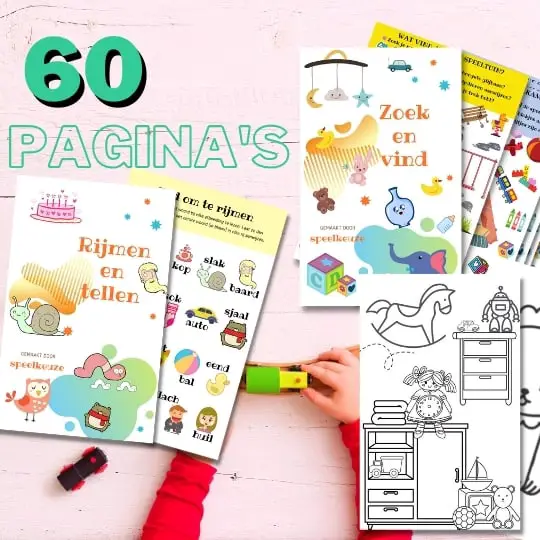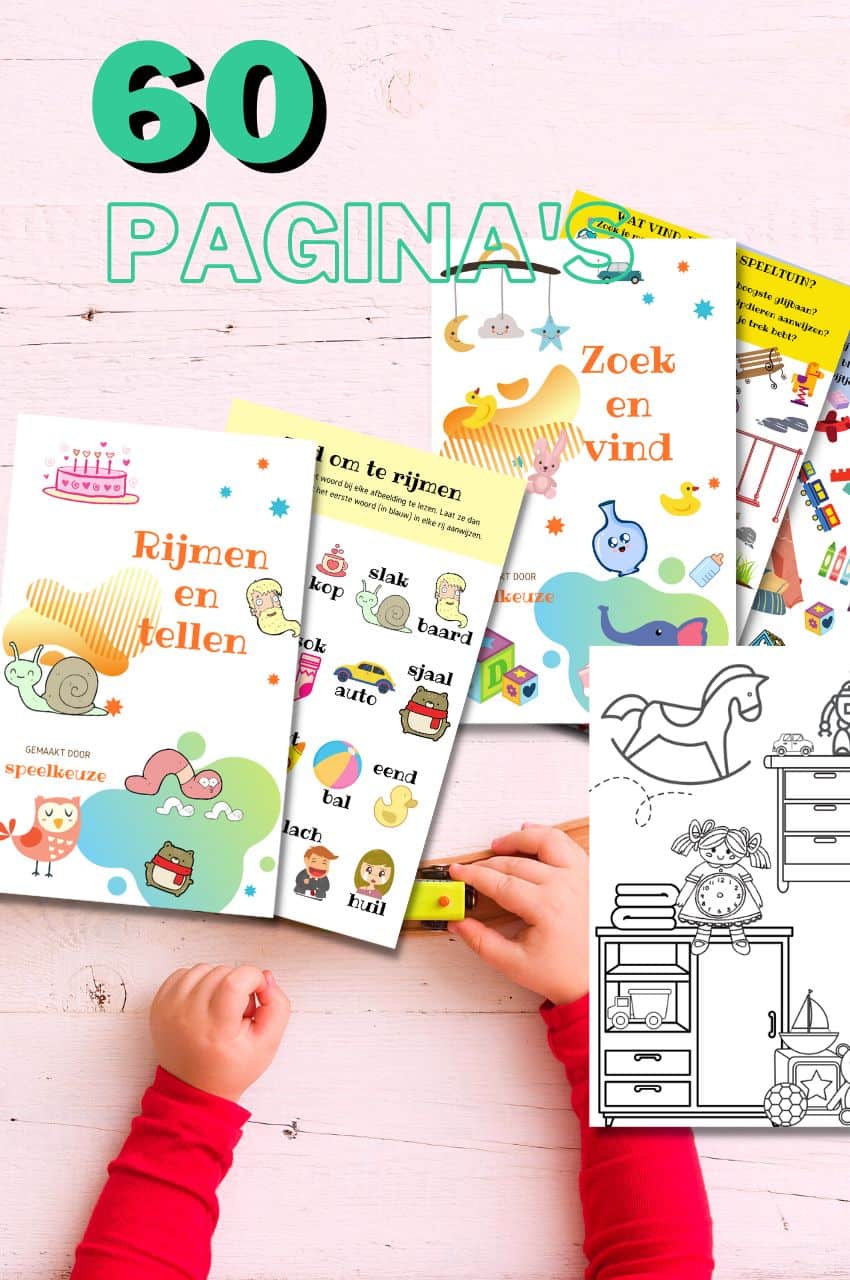Help! My toddler is playing wild! 10 tips to deal with it properly

Always something to do for the holidays or rainy day?
Play Choice now has the ultimate activity book collection, with over 60 pages of fun coloring pages and educational puzzles.
Different children have different temperaments.
Some who have recently learned to move throw their body from side to side, disregarding what might hit their heads.
On the other hand, cautious kids can stay with mom and dad, waiting for things to come to them.
In this article I want to reflect on and answer the question: What can I do with a toddler who plays wild?
Neither condition in a child is really preferable:
- one child risks danger
- while the other threatens to miss a learning opportunity.
Fortunately, parents can help by creating experiences that reinforce or encourage boundaries to break through a child's self-imposed boundaries.
It is important to note that there is an important developmental reason why children can be reckless and adventurous.
It's a product of their curiosity, and curiosity is incredibly good, according to dr. Kathryn Smerling, a New York child and family therapist who specializes in developmental issues.
Curiosity is the hallmark of early childhood and a curious child is one who will be very smart and very interested in the world and ask questions about the world in which he lives.
That questioning child is a child who wants answers. It is a hallmark of intelligence and opening up to the world.
With that in mind, it is important that parents, when considering conveying some caution by setting hard boundaries, do not also hinder a child's sense of discovery.
You have to be careful because you want you toddler don't scare. But you do want to clearly convey what is safe and what is not.
The keyword is “modeling”.
For much of their lives, and especially in toddlerhood, children view parents as the best example of how to navigate the world.
They observe and understand the world through their parents.
And because they have a developmental age where verbal communication and explanation are not particularly helpful, experiences become the key to development.
Smerling notes that if a parent wants a child to understand that the oven is hot, they may need to portray the experience of burning.
They can approach the oven and extend their hand animatedly before withdrawing their hand in exaggerated pain and saying, “Ouch! Hot!"
It's important to make this clear to them, because you certainly don't want a child to put their hand in the oven because they are adventurous.
But you have to make it experience-oriented, because that's how children learn at that age.

From toddler to toddler activity book collection
Educational games and coloring pages for 3 to 6 years
Your toddler and preschooler will love this e-book, along with the accompanying printables. He or she can play with it at every stage of development, together with mom and dad.
Buy at Bol.comWhat we discuss in this comprehensive post:
Ways to help a kid who is really playing wild
Maybe you recognize the child who is really playing too wild and you are looking for help what to do.
He bumps into people with a smile on his face and, when you're outside, he rides his tricycle around children playing, threatening to bump into them.
How can you get him to calm down?
The first thing to ask yourself is how you define wild.
- Does he scream while playing outside?
- Is he running around wildly and dragging other kids into his wild games?
Excited screams and wild Games its normal behaviour.
As parents, we can help kids channel their energy, but you don't want to stop them screaming and running when it's appropriate, like while playing outside.
On the other hand, if your child hurts himself or others or breaks things then he has a problem that needs to be addressed.
What Causes Rough Behavior?
There are a number of possible reasons for rough behavior.
Lots of Energie
Some kids (often, but not always, boys) just have a lot of strong energy.
Activities that others find enjoyable play, such as quietly building a block tower, can be very distressing to a child whose urge forces him to run and scream
And some kids are slower to develop impulse control.
Maybe your child is still at the point in development where wanting something translates into intervening without thinking.
Get attention
Also, your child could use roughness to get attention.
- He may not know exactly how to start a game with other kids, so he runs in the middle of their play without realizing it will disturb them.
- Perhaps your child will also get the most adult attention at home when he's rough?
- Or could he be anxious or upset about stress at home?
What can you do anyway?
Whatever the reason for your child's rude behavior, you obviously can't allow him to hurt people or ruin their stuff.
What can you do?
- Turn music time (or TV time or digital time) into music and movement time, so kids can get physically involved by dancing to songs or running around.
- If possible, go outside more often for extra outdoor play time.
- Give him "sensitivity training". He may not be aware of how his actions affect the other kids. Explain how his roughness hurts others. Modeling also works best here.
- Demonstrate the concept of pretending saying, “When you play with Yara on your bike, you can pretend to bump into her, but never actually bump into her.
- Help him involve other children in socially acceptable ways. Say: “Do you want to play blocks with Mees? Let's go ask him!"
- Set boundaries: Gently but firmly move him away from a situation when his behavior becomes destructive.
These are all good ways to get rid of energy and learn what is and isn't allowed.
I've also written about it these 20 fun games for your 2 year old where there are a lot of energy guzzlers to check out.
What else can you do?
How to Help a Wild Toddler Be Careful
- Understand that recklessness, adventurousness, and curiosity go hand in hand. They are important to children and you don't want to ban them.
- Toddlers will not learn caution through language, parents should model caution through role play and experience.
- Setting physical boundaries where children can and cannot play wild is another experiential learning method.
- But too cautious toddlers can be persuaded by playful parents who are willing to get a little wild and play to demonstrate.
But be glad your child is playing and exploring a little wild.
Children who are totally withdrawn and not curious about the world are children we really need to worry about.
Because that also means they're not having fun. Curiosity and Games go together.
And luckily the solution there is very simple: withdrawn kids just need to play more. It's that simple.
You may need to widen or narrow the boundaries depending on their development.
And that development is constantly changing. Development is so uneven, you never know when a child will move from one development stage to another.
You must remain observant and keep an eye on whether you toddler remains too wild or becomes more withdrawn, so that you can intervene adequately and get them more or less out of their shell.
Also read: These are the best ways to burn off energy

Always something to do for the holidays or rainy day?
Play Choice now has the ultimate activity book collection, with over 60 pages of fun coloring pages and educational puzzles.
Joost Nusselder, the founder of Speelkeuze.nl is a content marketer, father and loves trying out new toys. As a child he came into contact with everything related to games when his mother started the Tinnen Soldaat in Ede. Now he and his team create helpful blog articles to help loyal readers with fun play ideas.